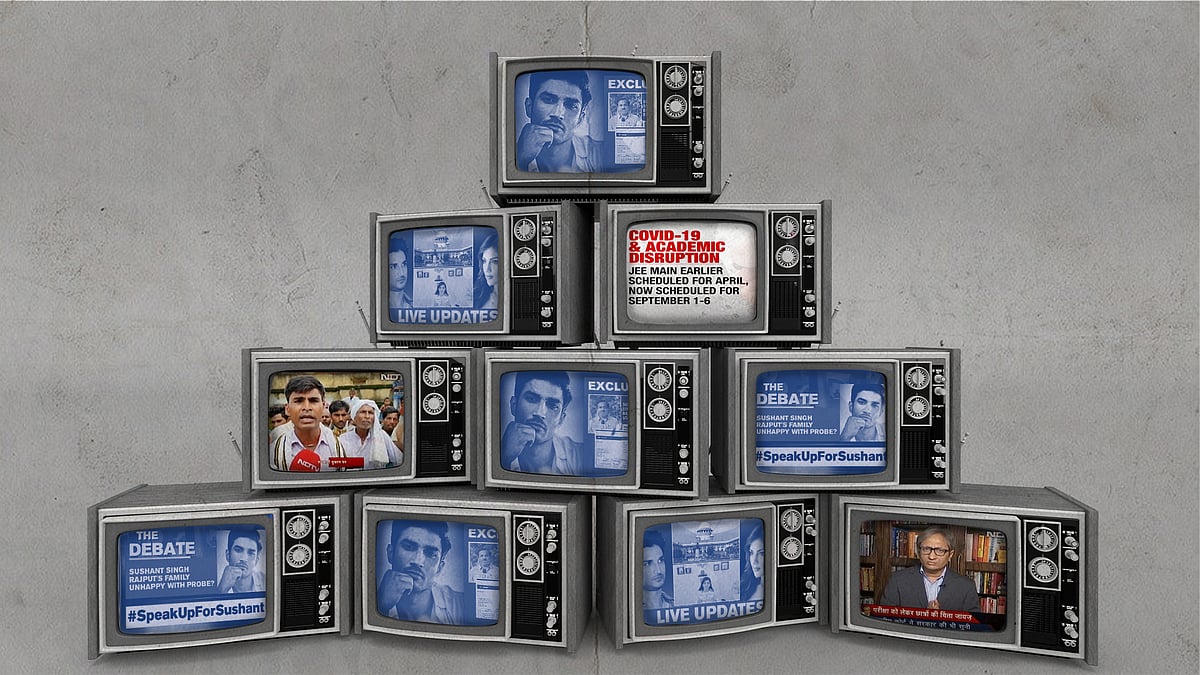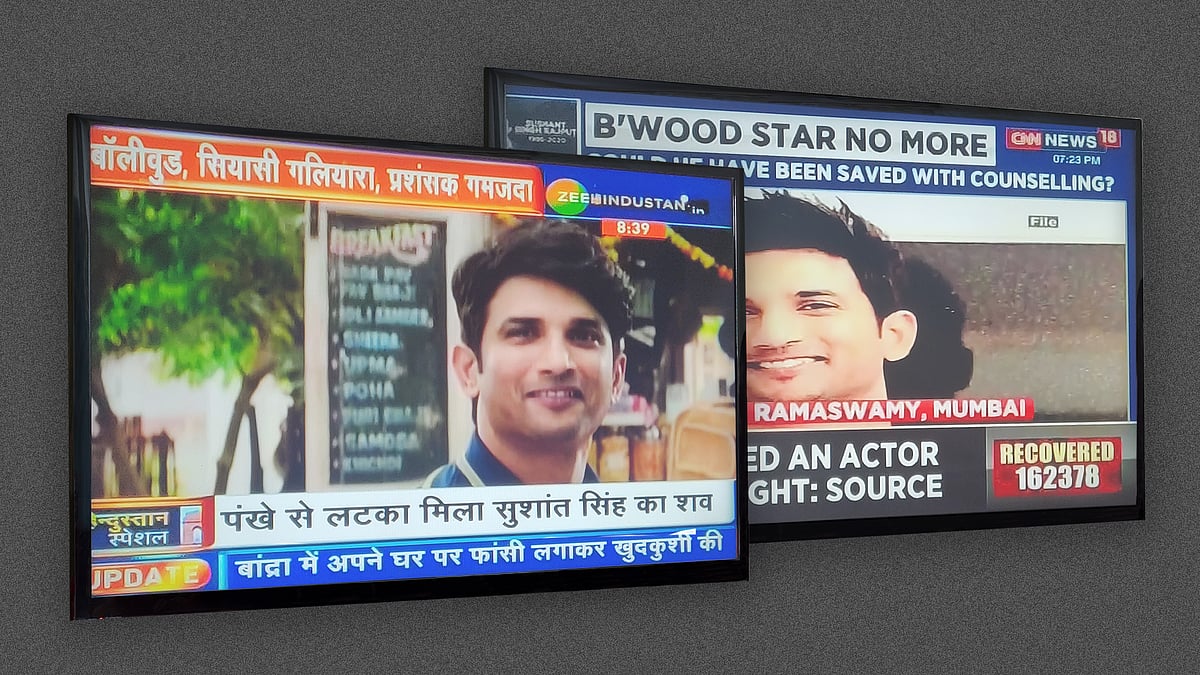SSR conspiracy theory: Why it worked and why you may still believe it
TV news played a big role as did anxiety caused by the pandemic.
The death of Sushant Singh Rajput on June 14, 2020, right in the middle of the coronavirus pandemic, led TV news anchors to unleash a mammoth media trial, which lumbered all the way into September.
History shows that conspiracy theories usually offer themselves as alluring, reassuring, and exciting resolutions to problems that are not to the liking of the general public. So, when the truth of an event in the media is mundane and not to the preference of a group, there is a likelihood that conspiracy will try to plug this gap.
The SSR media frenzy seems to fit snugly in this template. An AIIMS panel looking into Rajput’s death has maintained that he took his own life, and it should be noted that suicides are a tragic reality of Bollywood careers. In 2020 alone, 12 actors committed suicide. An informed critical inquiry could have led to urgent, even if uncomfortable, questions about the functioning of an essentially toxic film industry.
The SSR murder conspiracy took away from a corrective line of inquiry and replaced it with a murder mystery, the tragic killing of a young and talented underdog, which appealed more to the heart than the mind. It threw dirt at the reputation of opposing powerful groups such as the Maharashtra government to affirm the typical rightwing ideologue in India, and made scapegoats of individual figures such as Rhea Chakraborty.
Psychologists have found that, unlikely or likely, there are some features that are common to conspiracy theories. They also usually take care to mention that some conspiracies actually merit investigation, and might even be correct. Consider the DRASTIC team who have uncovered what might be a credible origin of the coronavirus and which governments might have actively been trying to hide.
But how well did TV news sell the SSR conspiracy? Let’s review.
A conspiracy has to be a possible hypothesis that is hidden from view, and can be uncovered by drawing patterns and “causal links”, making “logical observations”, conducting “investigations”. The seeming use of reason and logic to make deductions is a popular feature of conspiracies. But unlike SSR’s awesome workout videos, a typically weak conspiracy theory might only manage some awkward gymnastics in logical reasoning to distract from an illogical, wild speculation.
This was evidenced fairly well by the mediocre displays of Times Now’s barely Sherlockian “investigations”. From the now storied “Imma bounce” moment to Navika Kumar’s controversial “analysis” of SSR’s “ligature marks”, Times Now’s coverage of the SSR episode shows how the more conspiracy-inclined might abuse logic to seem smarter than they really are.
Clearly, such reasoning cannot lead to a conclusion and must only lead to a further possibility. Conspiracies arouse excitement because they are speculative, and they must be speculative since the actions suggested are hidden from public view. It turns out, conspiracy theories with a heightened motive to find patterns and causal links (such as a murder mystery) are the ones which thrive the most.
Simultaneously, conspiracy theories become resistant to logical critique by automatically casting people who debunk the conspiracy as “lily-livered liars” who are “part of the game” behind the scenes. TV news coverage was replete with casual accusations against those who believe the “suicide theory” having a “behind the scenes scriptwriter”, being part of a “gang” or “mafia” trying to hide the truth.
Psychological research has also suggested that people turn to conspiracies for compensatory assurance of control over their lives when they are feeling an existential or security threat.
For this reason, in a situation of general anxiety, it’s been concluded, a conspiracy theory can be very alluring but rarely satisfying. Conspiracies are strongly linked to a lack of sociopolitical control, a lack of psychological empowerment, and a lack of strong analytical skills. So, people who believe in an unlikely conspiracy remain stuck between the possibility of an empowering explanation and never actually possessing it.
A believer can become obsessed because a conspiracy rarely leads to the satisfaction of these insecurities but always maintains the possibility.
In the context of Covid, it can be argued that the SSR case provided fertile ground to ignore the general sense of anxiety, and focus on an issue people felt they could easily “participate” in with no real cost, and dump anger and frustration too. Basically, the SSR case gave people a distant, abstract issue to engage with, when a specific distressing issue was hard to ignore.
This was seen in the behaviour of many fans and SSR’s friends or aides, specially Ankit Acharya, who refused to give up what they claimed was a quest justice – #IndiaWithSushant, #JusticeforSSR – but was really just a want for fame, for being noticed, and, of course, for people confined to their homes to relieve Covid anxiety with some masala.
A Times Now interview with actress Krisann Barretto, a friend of Rajput, is telling in this regard. Asked if she could believe Rajput took his own life when it was first reported, she said, referring to reports of his suicide, “Honestly, I just wanted it to be a rumour.”
Researchers have also found that negative/immoral portrayal of someone else – individual or organisation – is a universal feature of conspiracy theories (even the most ridiculous ones which involve aliens). This gives believers a narcissism which needs external validation and sometimes paranoia to keep going.
This is seen in the demonisation of Rhea Chakraborty. Conspiracies have to valorise the believer as morally superior by allowing blame and immorality to be smacked onto someone else.
To hook people in, believers should be able to imagine themselves as morally just, virtuous followers of a denied truth, who are trying to fix an illness of society. So Chakraborty has to be totalised in immorality – murder, drug parties, black magic – and even has to be eliminated.
The divisions become clear: pro-Rajput, good; anti-Rajput, bad. All must fit this simplistic taxonomy. SSR is good: he must love science, have aspirations for space travel, be the winner of physics olympiads. He was happy and fit, he did kip-ups and somersaults. We side with him, and we share in his prowess. But Chakraborty is bad, she must be the turning point and stand in for the opposites of Rajput: she must have done black magic, poisoned him with forced medication, pushed him into depression, snatched his hard-earned money. All who question us must take on this baggage and put on its dirty clothes.
It is a ridiculously stunted logic which TV news abused for three long months. The loose ends in the SSR coverage could take weeks to sift through, with so much alleged and abandoned, at the cost of real lives, all when the world was being ravaged by the pandemic. Shakespeare, a literary master of conspiracies and murders, has a line in perfect symmetry with what TV media achieved last year: “Confusion now hath made his masterpiece.”
Today, though they caused a CBI inquiry, Republic TV, Times Now and Co have all but abandoned the case. Arnab Goswami had claimed, waving a fist in the air and shaking with furious anger, “If required, 80 years we will fight for Sushant Singh Rajput.” Evidently, this at least was not true.
To know more about conspiracy theories, read or watch:
The Psychology of Conspiracy Theories
Noam Chomsky on Conspiracy Theories
American Psychological Association Podcast on Why People Believe in Conspiracy Theories
 Has primetime TV covered anything beyond Sushant Singh Rajput lately? Sort of
Has primetime TV covered anything beyond Sushant Singh Rajput lately? Sort of
 Media most foul: How Sushant Singh Rajput’s death was turned into a spectacle
Media most foul: How Sushant Singh Rajput’s death was turned into a spectacle
